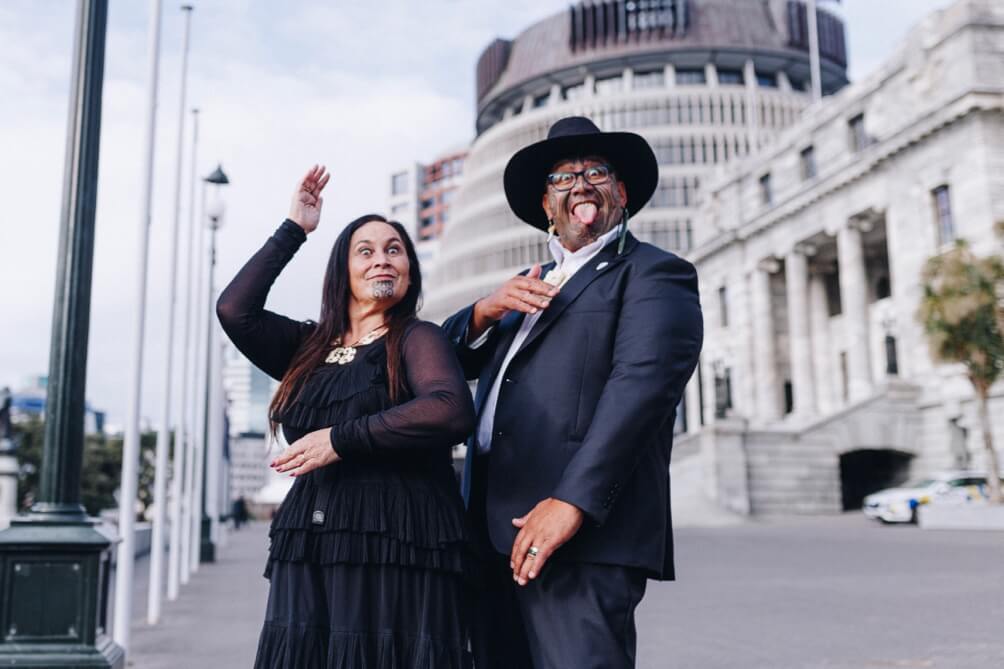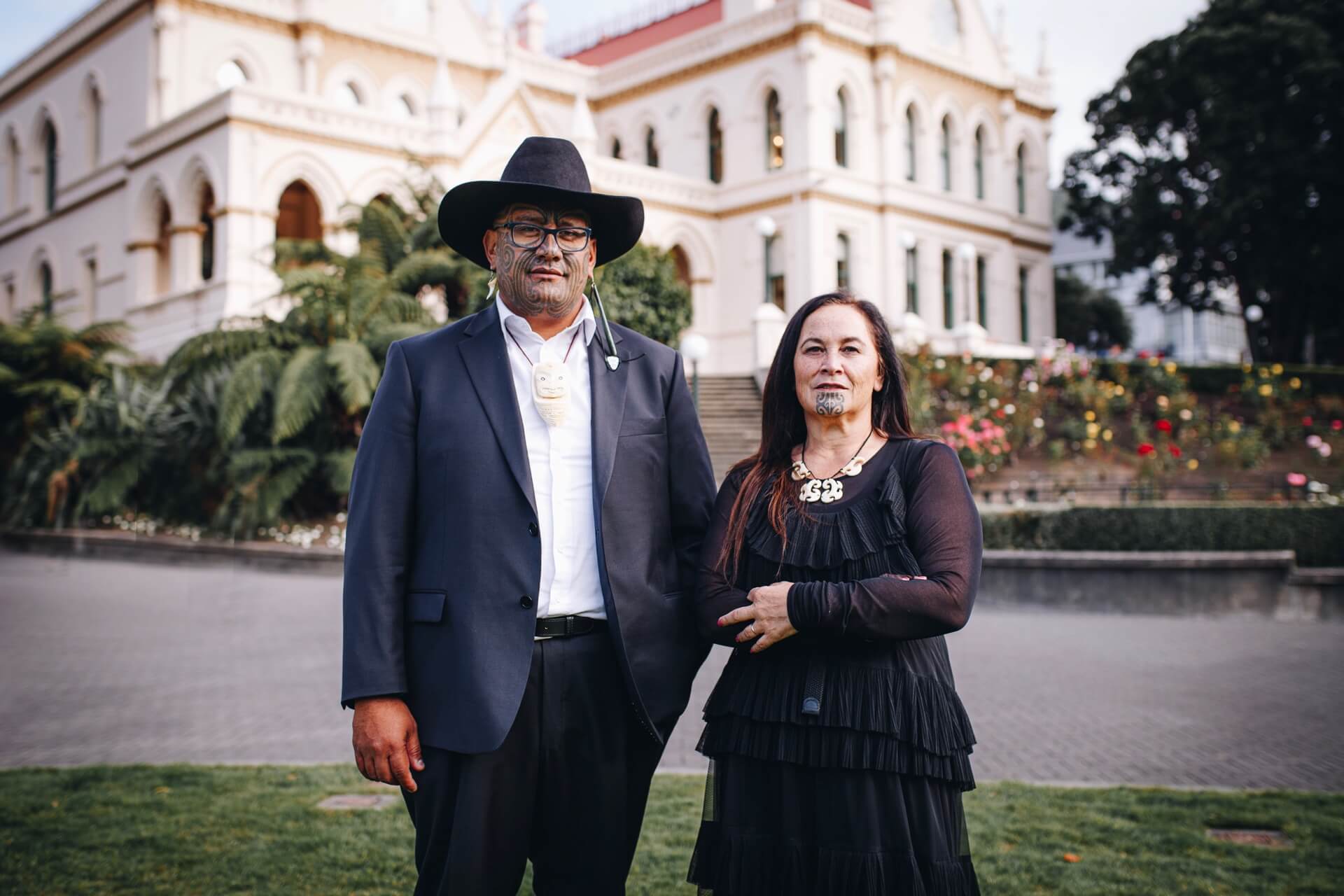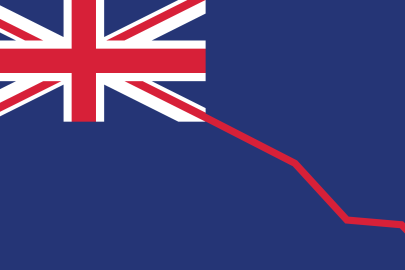Oct 4, 2022 Politics
On Sunday, 24 September 2017, the morning after a deadlocked election between the centre right and the centre left, Te Pāti Māori co-leader Te Ururoa Flavell took to TVNZ’s Q+A to tell viewers that the National Party’s Bill English deserved another three years in power. “I believe he can take the country forward,” he said. Flavell was out of Parliament after a crushing defeat in his Waiariki electorate and his morning television appearances became a series of valedictories. It was a bleak moment in Te Pāti Māori’s 13-year history.
Te Pāti Māori’s co-leader at the time, the irrepressible Marama Fox, was also out of Parliament. Labour had recorded a clean sweep in the seven Māori electorates. The night before, Fox told her supporters in Ikaroa-Rāwhiti that Māori voters had “gone back like a beaten wife to the abuser”. In an emotional interview with Newshub’s Patrick Gower, both leaders were left in tears, with Fox noting the personal sacrifices their MPs had made, the political wins they’d secured, and the uncertain future they were facing. In the previous three years, Flavell had driven the official pardon for the prophet and activist Rua Kenana, dramatically increased the budget for Whānau Ora, and prepared the groundwork to reform the increasingly unmanageable Māori Land Act. But it wasn’t enough. Flavell himself had perhaps inadvertently articulated the very basis of his party’s defeat: their confidence-and-supply agreement with the National Party. When Te Pāti Māori went into government with John Key’s National Party, they took five MPs with them. In 2011, they were reduced to three MPs. In 2014, they were cut down to two. And in 2017, none.
“The 2017 election was closer than many people remember,” says political commentator Shane Te Pou. “Before the special votes came in, National had 58 seats and Act had one seat in Epsom. That meant Bill English only needed Te Pāti Māori’s two seats to form a government. If Te Ururoa had got back in, taking Marama Fox with him, we might have been talking about a National-Act-Māori Party government in 2017.” Te Pou was the only political commentator to pick that Labour’s Tāmati Coffey would win Waiariki, explaining that “our people have always been Labour and so the relationship with National — nine long years of it — was never going to sit comfortably with Māori”.
Reflecting on that Sunday morning in September 2017, few commentators were picking Te Pāti Māori’s demise. “It looked as if they were finished,” says Te Pou, “but if a week is a long time in politics then three years is an eternity.” Within the following 12 months, the party’s senior figures resigned: Flavell and Fox stepped down from the co-leadership, as did party president Tukoroirangi Morgan, a former New Zealand First MP. This opened the field for a new generation of party leaders. In 2018, Che Wilson was elected president and Kaapua Smith vice-president. The pair were, according to Wilson, “joined at the hip” as they went about rebuilding the party structures. Wilson is named after the revolutionary Che Guevara and he brought his namesake’s vitality to the job. “Che and Kaapua put in the hard yards,” says Te Pou. “But never underestimate the Labour machine.” Labour can call on their volunteers to knock on doors, they can call on polling and advice from the head office or from the parliamentary office, and they have a real tested structure to hold it all together.
Labour is our oldest parliamentary party; Te Pāti Māori is the youngest. The key to political success in any parliamentary democracy is a cause, says Te Pou. Labour is the parliamentary wing of the trade union movement. It exists to secure economic and social gains for the working class. But what does Te Pāti Māori exist for? Perhaps it’s the parliamentary wing of the tino rangatiratanga movement. The Māori voice “at the table”, as Flavell was fond of saying. But in the three years the party was out of Parliament, the focus shift ed from “sitting at the table” to banging down the door, to paraphrase current co-leaders Rawiri Waititi and Debbie Ngarewa-Packer. It was Wilson and Smith’s job to facilitate a structure that would allow the party to do that. They undertook a review in 2018 and, at a pivotal AGM in October that year, the party left the co-leadership vacant. New co-leaders weren’t elected until 2020. It was this willingness to exercise patience that allowed the party to slowly and carefully consider its long-term strategy.
In 2018, Wilson said, “We don’t need to be in Parliament to be a political voice.” Instead, the focus would shift to a wider ‘flaxroots’ strategy emphasising messaging, branch and electorate structures, and candidate selection. That slow, deliberate strategy of tilling the soil led to a bumper crop in 2020. Former Labour Cabinet minister John Tamihere stood in Tāmaki Makaurau, and the co-leaders-to-be, Ngāti Ruanui leader Debbie Ngarewa-Packer and East Coast leader Rawiri Waititi, stood in Te Tai Hauāuru and Waiariki respectively. In the run-up to the 2020 election no one was picking Te Pāti Māori to return. “It was the Covid election,” says Te Pou. “Labour won a majority and they took seats that are usually the deepest blue. Whangārei in the north to Rangitata in the south.” On election night — 17 October — the Labour tide swept in. But beneath the tide was a powerful left -leaning undercurrent. The Green Party’s Chlöe Swarbrick won the Auckland Central electorate against candidates from both National and Labour. Then, further south, in Flavell’s old electorate, Waititi had seemingly come from nowhere to defeat Labour’s Coffey. Te Pāti Māori was back. Ngarewa-Packer fell short in Te Tai Hauāuru, but with Te Pāti Māori gaining more than 1% of the party vote, Waititi took her to Parliament, too, as a list MP.
Rawiri Waititi’s voice can fill a room. That booming voice is useful for gaining attention in Parliament. In 2021, Waititi made headlines for refusing to wear a tie (what he called a “colonial noose”) during sessions in the House. The party co-leader eventually won the “tie war”, as the New York Times styled it, as his name went around the world. But in his Waiariki electorate, which forms a triangle between Katikati in the west, Waihau Bay in the east, and Turangi in the south, Waititi is hardly known as the tie guy: he’s a kapa haka expert, a Ringatū minister, an iwi leader and only then a politician. Perhaps ‘political orator’ is a better description than ‘politician’. Waititi often speaks in terms of manifesto. “I will continue to challenge racism in the House, its legislation, its laws, its offices, [and] its leadership,” he tells me.
Labour’s Māori caucus is concerned with achieving change within the system. Waititi and Te Pāti Māori, on the other hand, are concerned with achieving change to the system. “My biggest priority is to break down the system that has been designed to ensure tangata whenua are at the bottom of the heap,” he says. “I will continue to challenge the house that upholds the mana of the Crown [including] the racist electoral roll that continues to lock us out for a [five-year] period from participating in this country’s democracy”. At the moment, Māori voters can only switch between the Māori roll and the general roll every five years. Waititi had a private member’s bill that would remove that arbitrary rule, achieving a significant systemic change for Māori voters, and in June the government picked up the issue, announcing that they would finally move to a switch-any-time solution.
This strategy — banging down the door rather than taking a seat “at the table”, as Flavell and his predecessors did — is integral to explaining Te Pāti Māori’s ability to not just return, but to rise — first, in Waiariki in 2020, and in the last six months in the polls. In March, the 1News Kantar public poll had Te Pāti Māori holding the balance of power in Parliament. In May, the Newshub-Reid Research poll found the same — Te Pāti Māori would hold the balance of power and determine who formed the next government. Then, in August, the Roy Morgan poll had Te Pāti Māori surging to 4% of the party vote and, as it had in the previous polls, holding the balance of power.
Four per cent was the highest support level the party had achieved since 2010. The results were a testament to the party’s new oppositional and systemic approach. “The strategy we have used in our electorate is called the ‘Pāua ki te toka’ strategy,” says Waititi. “‘Kāore te toka e haere ki te pāua, me haere te pāua ki te toka’ — which translates to ‘the rock does not go to the pāua, the pāua goes to the rock’. Politicians waste a lot of taxpayers’ money on infrastructure like offices that are often empty and expect people to go to them. They’re usually set up in the major centres of their electorates and are inaccessible to the whole electorate. We decided not to invest in offices but to invest in vehicles with our branding, like mobile offices. This has given us the ability to engage across the electorate by going to the people, taking our office to the hardto-reach areas and oft en forgotten kāinga whilst still being able to cater to the major centres.
” The chief challenge for any Māori electorate MP is geography. Waiariki is a similar size to Belgium. Te Pāti Māori’s strategy to overcome that — opting for mobile offices over fixed offices — is simple yet remarkably effective. Political commentators in Waiariki (including Te Pou, who is from Kawerau) are picking Waititi will cruise home in 2023. Partly because of smart politics, but partly out of experience.
When Waititi stood in Waiariki in 2020, winning against that incoming Labour tide, it wasn’t his first time standing for Parliament. He had previously stood in Waiariki in 2014 — for Labour. It was a fractious election campaign. Te Pāti Māori’s Te Ururoa Flavell ran a defensive campaign against Annette Sykes of the Mana Movement, a party established in 2011 when Hone Harawira split from Te Pāti Māori then kept his Te Tai Tokerau seat in a byelection. Sykes had run an insurgent campaign against Flavell in 2011, reducing his share of the votes from almost 70% in 2008 to a comparatively modest 43% in 2011.
The stakes at the 2014 election, then, were high. Would Sykes and the Mana Movement take Waiariki, depriving Te Pāti Māori of another seat? In this contest Waititi — as the Labour candidate — found himself stuck in the middle. At campaign debates between the candidates he would oft en pull out his guitar and strum up a song. That gesture was, in the heat of those debates, a necessary defusion. Flavell and Skyes had, at best, a robust and, at worst, a stroppy relationship. Claims and counterclaims fl ew. Sykes said Mana could never work with Te Pāti Māori while they were in a relationship with the “racist” National Party. In riposte, Flavell said Te Pāti Māori could never work with Mana while they were in a relationship with “the big German” (in 2014, Mana merged with the Kim Dotcom-backed Internet Party to contest the election as Internet Mana).
But when Māori Television’s Native Affairs polled Waiariki they found 66% of voters were keen for the two parties to work together. In this environment, where the two front-runners were fighting over their partners instead of finding common ground, it should have been possible for Waititi to, in then Labour MP Shane Jones’ words, “come through the middle”. But 2014 wasn’t Waititi’s year. He did however record a respectable second place, narrowly beating Sykes and Internet Mana. With his cowboy hat, his guitar and his sometimes cutting turns of phrase, Waititi had introduced himself to the Māori parliamentary world and announced his aspirations. In the week after the election he told Te Karere (translating from the original te reo Māori to English), “This is just the beginning — I’m the youngest candidate in the race.” Six years later, he would win the seat for Te Pāti Māori.
What changed? The whisper network in Wellington has a theory: Waititi’s father-in-law is the former Labour MP and Māori political power broker John Tamihere. The theory goes that, after failing to engineer his son-in-law into Parliament through Labour, Tamihere would try to do so via Te Pāti Māori. But that’s a shallow and, on the evidence, false reading. Waititi’s politics were never a neat fit for Labour. He had more in common with Te Ururoa Flavell and Annette Sykes, members of the two kaupapa Māori parties, than with his Labour Māori colleagues who must reconcile their kaupapa Māori politics with social democratic policy. Thus, when the Māori king Te Arikinui Kiingi Tūheitia announced that he would vote for Te Pāti Māori over Labour in 2017, Waititi was moved. The king in his speech called for political unity, urging the Māori and Mana parties to set aside their differences and work together as a single kaupapa Māori party that could pursue lasting, systemic change.
After hearing that call, Waititi went on to endorse Te Pāti Māori in an interview on Radio Waatea. “The Labour Party is like a mainstream school with a Māori class attached to it,” Waititi said. “We’ve actually got to be the governors of our own destiny and I believe Te Pāti Māori is able to do that for us. The king has actually opened the door for the rest of us to start looking at how we look at a united approach to our political desires keeping our mana motuhake intact.”
Talking to Waititi five years later, he still emphasises mana motuhake and resisting compromise. “We are a humble team, but one that can go head to head with the best political brains in the country and world,” he says. “Our success does not sit with one or two people; our success sits in our ability to continue to listen to our people, to stop the rot of compromise and to stand proud in who we are — we are tangata whenua. We are Māori.”
The nature of government is that compromises go both ways. When Te Pāti Māori were governing with National, both sides were required to compromise on certain issues. But, as in any relationship of unequal power, the smaller party paid a higher price for the compromises they made. One of the driving forces behind Hone Harawira’s decision to split from Te Pāti Māori was the requirement that their party compromise and vote for Budget 2010 and the increase in GST. Waititi believes that this “rot” — compromise — is destructive to the systemic change his party is seeking.

Debbie Ngarewa-Packer is wearing a red blazer over a black top. The co-leader is standing in the mahau (porch) of her marae for a campaign shot. It’s a crisp colour combination. The white background offers a useful contrast, but more importantly the red, black and white are the tino rangatiratanga colours. It’s artfully on-brand for a co-leader who is probably best described as a high achiever: Ngarewa-Packer is the former chief executive of her Ngāti Ruanui rūnanga, a Stanford University alumna, and an accomplished activist. In 2004, she helped rally a Taranaki contingent to join the foreshore and seabed hīkoi as it made its way to Wellington.
This is the fighting spirit Ngarewa-Packer has brought to Parliament. In August, her private member’s bill to ban seabed mining was pulled from the biscuit tin. The bill is, in many ways, personal for Ngarewa-Packer — the culmination of decades of iwi work in Taranaki. In a landmark victory in 2021, the Supreme Court upheld a decision to cancel marine discharge consents for the mineral company Trans-Tasman Resources. For Ngarewa-Packer, these struggles and fronts are linked. “There is no Planet B,” she tells me. “We’re collectively minded, and everything we do is focused on our mokopuna and future generations. The moana is our pātaka, our wellbeing. It hosts our taonga. Our iwi in Taranaki live with the consequences of greed and capitalism; [with] inequities of displacement from the confiscation of our whenua. Our waters are polluted. And we are still here, long after these companies extract and then bugger off , leaving the mess for us taxpayers to pick up. We don’t come and go.”
Rhetorically, this is a different Te Pāti Māori. Is that a deliberate strategic change? “It’s just us being our natural selves,” says Ngarewa-Packer. “Breaking down barriers so that we can bring our people with us. Being relatable, dressing, talking and moving as us in a place that looks like anything but us. Reminding Aotearoa every day of our tangata whenua status. At my maiden speech I said we’d make sure our people will be heard and seen, and we will stay pono to that.”
As Trevor Mallard steps down from the speakership, Te Tai Hauāuru MP Adrian Rurawhe is taking the chair. That means, according to several political commentators, that he may opt to run as a list-only MP in 2023. Would that clear the way for Ngarewa-Packer? “I’m absolutely aiming to win in 2023 and 2026,” she says. “I’ve always been focused on supporting and fighting for our Te Tai Hauāuru whānau, hapū, iwi and community, and I’ll continue to ask for the privilege to do that as their electorate MP. Opportunities have presented [themselves] all the way through — mostly in how consistently we show up and speak up for our people in and out of the House. I think we’ve done so authentically and that’s what’s going to get us support at elections.” On current polling (assuming Waititi retains his seat), Ngarewa-Packer will return to Parliament as either a list MP or as the MP for Te Tai Hauāuru, alongside at least one, perhaps two, additional MPs. In 2020, Heather Te Au-Skipworth and Tākuta Ferris were ranked three and four on the list respectively. Numbers like these would lift Te Pāti Māori to its best result since 2008.
But 2008 remains the party’s most instructive year. In negotiations following that election, at which the National Party headed by John Key was swept into power, then Māori Party co-leaders Tariana Turia and Pita Sharples agreed to join Key’s government. Nine years later — after some triumphant wins but a larger number of bitter compromises — their party was gone. According to party insiders and the current co-leaders, the lessons from that period have been firmly learned. Te Pāti Māori isn’t necessarily seeking to join the current government nor to prop up a new administration. Instead, it’s focused on, to deploy a cliché, holding government to account. “Inequality, the cost of living, housing, health and opportunities for our rangatahi” are the issues the next election will centre around, says Ngarewa-Packer. “Climate and environmental justice are also huge.”
These aren’t ‘identity politics’ issues, as some commentators allege. They’re practical, materialist and Māori issues. This suggests that, if Te Pāti Māori were to hold the balance of power, there are two options available: join a Labour-Greens government or sit on the cross benches, voting issue by issue. National Party leader Christopher Luxon is holding out hope that he might be able to bring Te Pāti Māori around to a deal with his party. In an interview with RNZ in May, the former Air New Zealand CEO left the door open to a hypothetical coalition (with the important qualifier that any firm commitments are premature). But, for Waititi, joining the National Party in coalition is unlikely — especially if that hypothetical coalition included the Act Party. In May, the Te Pāti Māori co-leader put Act on blast for its “racist rhetoric” and anti-Māori policies, ruling out joining any government that includes the David Seymour-led party in its current iteration. Ngarewa-Packer echoes these concerns, saying there is a “real fear of an anti-Māori government getting in and undoing everything that has been put in place to advance Māori over these last few years”.
For minor parties, joining government is often a curse. In 1999, Winston Peters’ New Zealand First only just made it back to Parliament after a turbulent term in the Jim Bolger and Jenny Shipley government. The party was turfed out at both the 2008 election and the history-looping 2020 election, after joining Helen Clark’s and Jacinda Ardern’s governments respectively. Minor party United Future eventually succumbed to the same fate, petering out after one term in the Clark government then three terms in John Key and Bill English’s government. Even Te Pāti Māori had their three-year period out in the cold after the 2017 election. Only Act, helped by National’s patronage in Epsom, and the remarkably resilient Greens are defying the minor-party curse.
The question, then, in light of those experiences and with the knowledge they could decide who forms the next government, is: What to do? National? Surely not, says Te Pou and other commentators. Labour? It’s a risk. The cross benches, voting issue by issue? It’s untested, but for this Te Pāti Māori — one that guards its independence and seeks lasting structural change — perhaps it is the only option.
–
This feature was published in Metro 436.
Available here in pdf format.







